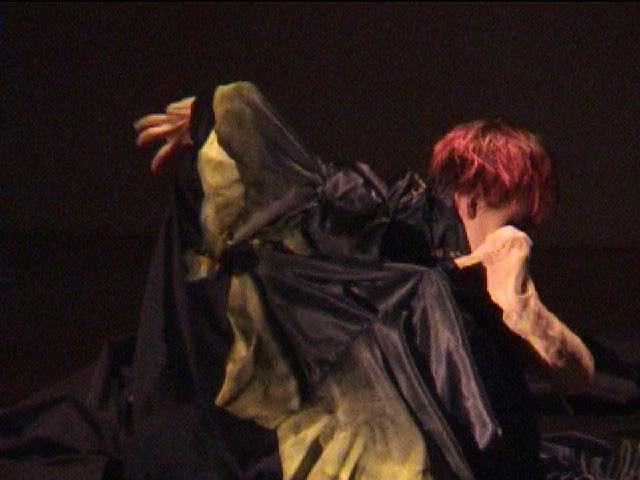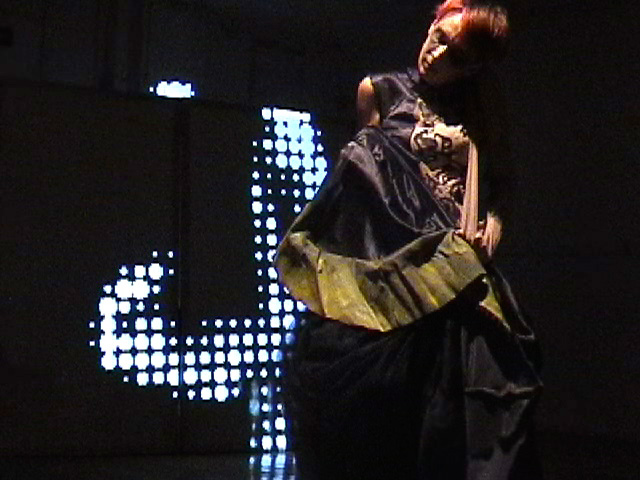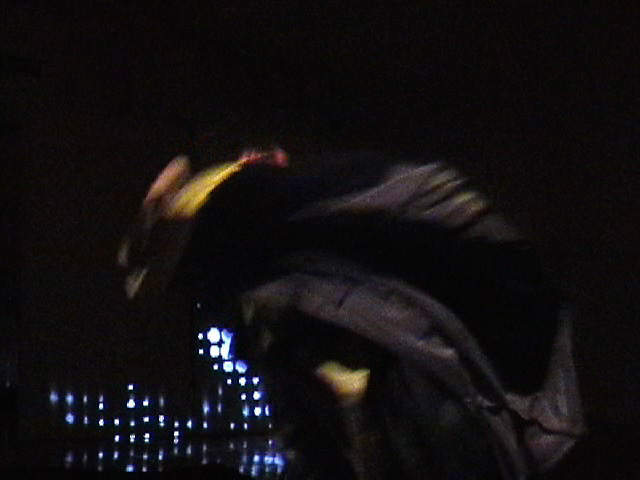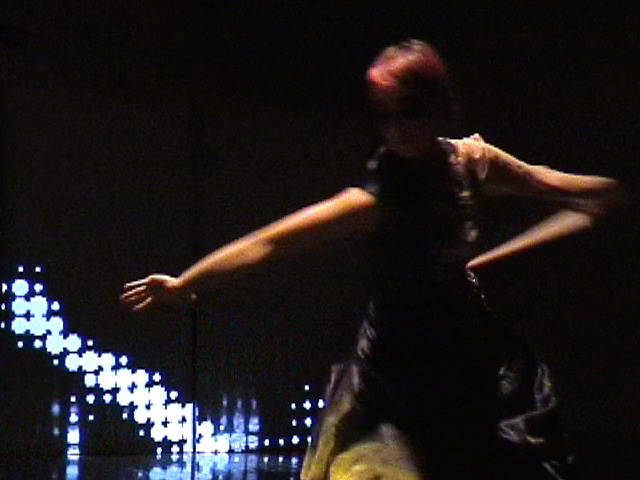DAP-Lab is a cross-media lab exploring convergences between performance, telematics, textile/fashion design and movement, clothing and choreography, visual expression, film/photography, and interactive design. As an experimental process, research participants from performance, fashion, new media and engineering explore the intimate relations between textures in motion, design ideas for smart fabrics and wearables, within a film-and-performance studio environment which allows the garments to be used for interaction with physical camera and real-time processing using digital software that responds to body movement and sensory processing. The multiple processes join skin and fabrics, color, sound and visualization technologies. in 2006-2009, The DAP-Lab will also enter an eScience projectdevelopment phase during which its members, with partners from the School of Engineering and Design, build DanceGrid, a Grid-enabled Virtual Performance Environment for Telematic Dance.
Founded in 2004 by Johannes Birringer and Michèle Danjoux, the Lab is now housed at Brunel University and continues research partnerships with multiple sites in the USA, Japan, and Brasil which have formed the ADaPT network on performance telematics since 2000. DAP-Lab also connects ongoing research investigations and productions in dance (Digital Cultures) with performance/science collaborations (METABODY, TransNet), and brings these partnerships into knowledge transfer with other performance, multimedia and electronics engineering research centers in the UK and abroad.
The Founding of DAP- LAB
Emerging from the Telematic Performance Lab at Nottingham Trent University, the first phase of design/performance experiments directed by Johannes Birringer and Michèle Danjoux in autumn 2004 featured design concepts by Danjoux, Jo Cope and Gemma Harrison. These initial workshops brought together young designers from fashion (Cope, Harrison, later joined by Siobhan McHugh and Emma Wilkes), performance (Marie Denis, Natalie Verhaegen, Natasha Stott), photography (Yoon Bo Shim), and fine art (Helen Knight).
The second workshop series (March - May 2005) expanded the film and movement studies of DAP-Lab's investigations focussing on Danjoux's design-in-motion principles, combining the research into sensual technologies and live streaming performance.
The March 2005 workshop culminated in an all night live interactive performance of "Telematic Dress"
The "Emergent Dress" signals phases III-IV of the DAP-Lab, featuring design concepts by Michèle Danjoux, and consolidating online collaborative partnership drected by Birringer with the Department of Dance, Ariziona State University. See our partner site in Arizona.
In 2006, the Lab's relocated to Brunel University, London, starting research collaboration between artists, scientists and engineers for Phases IV-V. These phases resulted in the development of new prototypes [Teshigahara collection], and the production (Phase VI) of the performance work Suna no Onna exhibited in London in late fall of 2007 and spring of 2008.
The Lab's subsequent performance research project (2008- 2010) is entitled UKIYO (Moveable World), developing new transcultural partnerships with artists in Japan. The new production went on tour to Slovenia in 2010 before premiering at Sadler's Wells, London.
DAP-Lab now works at the cutting edge of new peformance concepts and architectures with intelligent wearables and audio-visual choreographies. After a longer development phase, Danjoux's new audiophonic wearables form the core of for the time being, staged at Watermans Art Center in a first version of the new opera in 2012. Built as an homage to the 1913 futurist opera "Victory over the Sun," the opera was considerably expanded for its premiere at Sadlers Wells in April 2014.
The DAP-lab's most research program was supported by the EU Culture Programme as part of the collaborative METABODY grant project (2013-2017). DAP-Lab was one of the co-organizers of the Metabody Project, and from 2015 onward began to develop a series of large scale kinetic atmospheres (kimospheres) which have been exhibited in Spain, Germany and England.
Research Objectives
I. Initial Formulation of Objectives of the Clothing as Sensual Technologies (2004)
To portray clothing as an extension of the human form and intimate functions, using bodily movement with structures and shape to deal with the transition through spaces and abstraction, and the evolution iof shape and color. Using the body as a mechanical axis for the expansion of evolving form and movements through garment pieces. Gradually: to explore clothing as intimate and extimate behaviors in a performative sense -- how do we use "sensual technologies" (clothing and cothing movement, responsive fabrics, screened fabrics) to express and communicate.
Outer core representation of the person's relationship to the world space around her (consumer experience), references to the packaged body, commodity, desirability, through color and symbols.
Middle stage white outer dress - the reflection and portrayal of the self through the interaction with the people that surround us. The outward projection of our self to the world.
Changing head forms and step movement reference to the Japanese influence and symbolism within the piece, symbolic of the cutting of the hair, tradition linked/contrasted with westernization, the transition of change and suppression to freedom.
Dark into light series, with slight biblical reference (On the seventh day let there be light)
Opening garment - last stage of transformation, the revealing of the inner self, the deeper spiritual depth and beauty. Other reference points in the sequencing are to cubism, futurism, androgyny, and the conception of this movement sequence as an animation (animated film)
II Objective of the Clothing (Gemma Harrison)
Dream split vision awakening with interior voice, crackling branches over water in the dusk
Marie and her hands under the yellow tree, motion responds to wind blossoms
in the distance one large pool, sky bottomed out and fallen over desert sand


now light bubbles float across the street, she sees odd reflections of herself on the pavement


Notes on Harrison designs:
Areas of research:
- Mental Illness and Schizophrenia
- A play between physical and mental states (introspection/outward representation)
- Transient states, (movements, pace, sequencing)
- Abstract representations of the ‘altered’ mind and dissociated state (as in mental illness/schizophrenia). Compulsive/obsessive movements etc…
- Sound and image distortions to represent chemical imbalances or the higher state of consciousness
- Uses of symbolic imagery and props, e.g. ‘The Cosmic Tree (branch),’ toxic plants; dipped fingers (comment on threats and pollution in the environment) etc.
Future considerations:
- Integration of exploration of the inner self such as singing, painting, drawing (with branch)
- Exploration of design and emotional affect, looking at physical and mental conditions/perceptions
- Play with introduction and saturation of colour (yellow) through editing.
Dans Sans Joux
Dans sans joux is a label and laboratory for fashion/performance and interaction design. It was founded by Michèle Danjoux and Johannes Birringer in 2007, after three years of creative research conducted in the DAP LAB which started in Nottingham and now is in London.
Research/Production team
Lab directors and principal investigators: Johannes Birringer (Performance, Brunel University) & Michèle Danjoux (Fashion, LCF).
Paul Verity Smith (Sensor programming/Photography, Research Associate), Oded Ben-Tal (music, Research Associate), Katsura Isobe (Dancer), Helenna Ren(Performance, Research Associate), Doros Polydorou (3D motion graphics, Brunel University), Hsueh-Pei Wang (design, technotextiles, Brunel University), Dr Maozhen Li (Engineering and Design, Brunel University, Research Associate); Dr Jinsheng Kang (Engineering and Design, Brunel University), Dr Olu Taiwo (Performance/Media Art, Research Associate, Winchester University), Mamen Rivera (lighting, Research Associate), Caroline Wilkins (music, performance), Miguel Alonso (Ligthing, Research Associate, Barcelona), Yiorgos Bakalos (actor, Research Associate), Anne Laure Misme (Performance, MA Brunel Drama), Sandy Finlayson (sound processes, Research Associate), Jennifer McColl (MPhil Brunel Drama), Giulia Tonucci (Visiting Student, Bologna), Luca Forcucci (PHD researcher, DMU), Yoko Ishiguro (performance artist;MA Performance Making, Brunel) , Ross Jennings (actor/BA Theatre, Brunel),Aggeliki Margeti (dancer;MA Performance Making, Brunel), Oliver Doyle (sound, music), Cameron McKirdy (software programmer/performance arist;BA Theatre,Brunel), Graeme Shaw (Sound Technican; Music/Sonic Arts, Brunel),John Richards (electronics engineer/sound artist; de Montf University), Aleksandar Tomic (director, Philharmonic Lights) , Hae-In Song (dancer/choreographer/techno-shaman, Phd researcher, Brunel),Vanessa Michielon (dancer, Turino/London), Manaskarn Insang (dancer, Bangkok), Rosella Galindo (dancer/researcher, Mexico DF), Sara S. Belle (musician/performer, MA Music Brunel); Zhi Xu (dancer/choreographer, Phd researcher Brunel).
Associates: Chris Bishop (network artist/software artist; Monash University), Azzie McCutcheon (choreographer/dancer), Martina Reynolds (theatre producer/social scientist), Maria Wiener (Digital Artist/Postdoctoral Fellow), Umut Ozbay (sound, Istanbul); Niluefer Ovalioglu (Performance, Research Student), Cidinha Fursan Bendixen(Creative Collaborations, Research Student), Nam Eun Song (Performance, Research Student, Jo Cope (Fashion Researcher), Siobhan McHugh (Fashion Researcher).